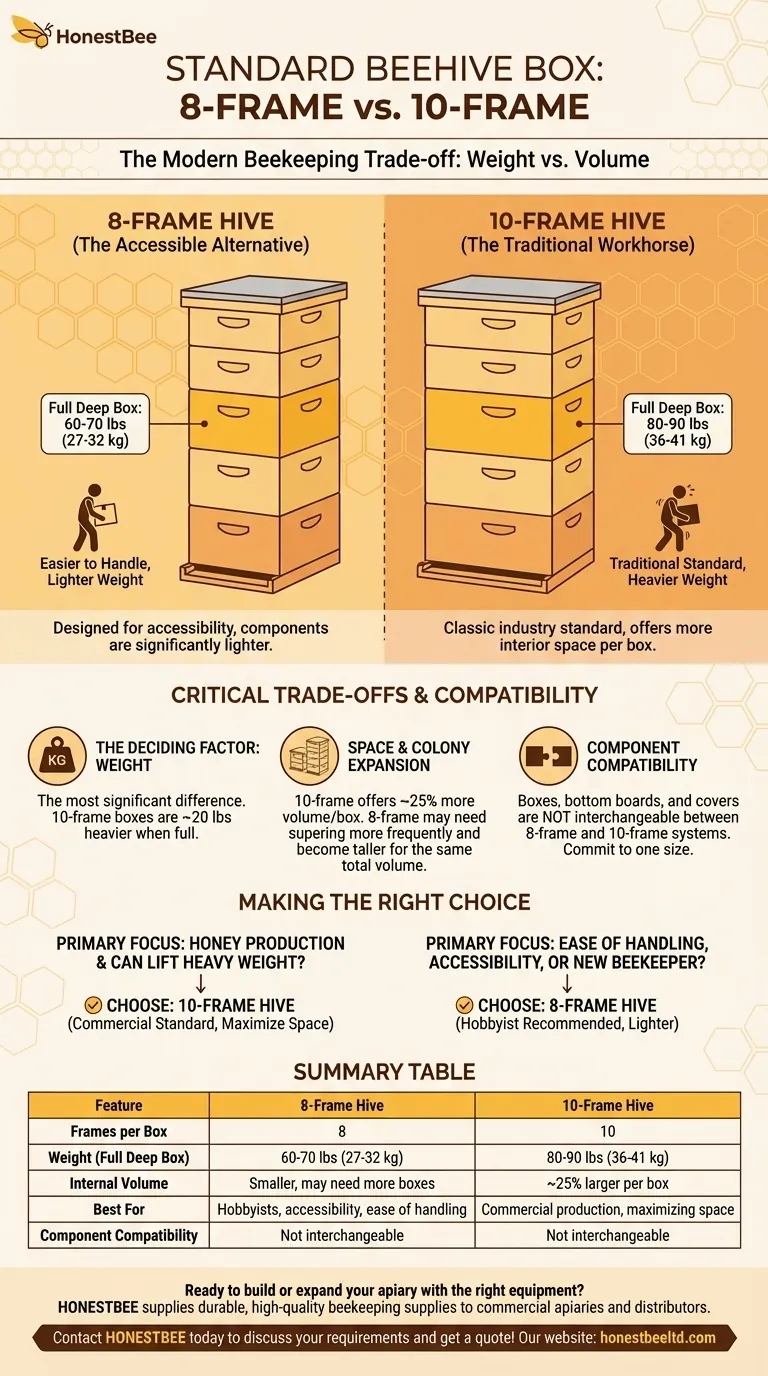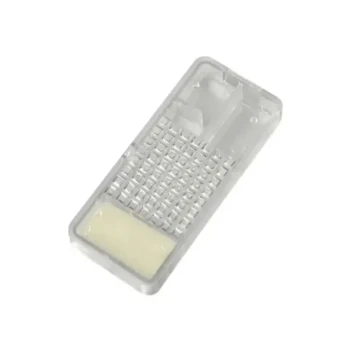A standard beehive box holds 10 frames. This configuration, known as the 10-frame Langstroth hive, has long been the industry default. However, a newer 8-frame version has become extremely popular, creating two common "standard" sizes for modern beekeepers to choose from.
The question isn't just about how many frames fit in a box, but understanding the fundamental trade-off you must make: choosing between the heavier weight of a 10-frame hive and the reduced volume of an 8-frame hive.

The Two Standards of Modern Beekeeping
The Langstroth hive, with its removable frames, is the foundation of modern beekeeping. While both 8-frame and 10-frame hives use this same brilliant design, their dimensions differ, which has significant practical implications for the beekeeper.
The 10-Frame Hive: The Traditional Workhorse
The 10-frame hive is the classic industry standard. It offers more interior space per box compared to its 8-frame counterpart.
This additional volume provides more room for the queen to lay eggs and for the colony to store honey and pollen.
The 8-Frame Hive: The Accessible Alternative
The 8-frame hive is a more recent innovation designed to make beekeeping more physically accessible. The boxes are narrower, holding two fewer frames.
While the components are the same height as their 10-frame equivalents, they are significantly lighter and easier to handle, which is the primary reason for their rise in popularity.
Understanding the Critical Trade-offs
Choosing between these two systems requires weighing the pros and cons of each. Your decision will impact everything from your physical effort to your hive management strategy.
The Deciding Factor: Weight
The single most important difference is weight. A deep 10-frame hive box filled with honey, brood, and pollen can weigh 80-90 pounds (36-41 kg).
Lifting this much weight is a serious physical challenge for many people. In contrast, a full 8-frame deep box is much more manageable, typically weighing 60-70 pounds (27-32 kg). This difference is often the sole reason a beekeeper chooses the 8-frame system.
Space and Colony Expansion
A 10-frame box offers approximately 25% more volume than an 8-frame box. This can support a larger bee population and greater honey storage within a single box.
An 8-frame hive may fill up faster, requiring the beekeeper to add new boxes (a process called "supering") more frequently. A colony in an 8-frame hive may ultimately need to be taller than a 10-frame hive to provide the same total internal volume.
Component Compatibility
The boxes, bottom boards, and covers of 8-frame and 10-frame systems are not interchangeable. You must commit to one size for your hive.
While you cannot mix boxes of different widths, the frames themselves are often the same depth (deep, medium, or shallow), allowing for some flexibility if you manage both types of hives.
Making the Right Choice for Your Goals
Your choice of hive size should be based on your physical ability and beekeeping philosophy, not on which is considered "best" by others.
- If your primary focus is maximizing honey production and you can comfortably lift very heavy weight: The 10-frame system offers the most space per box and is the commercial standard for a reason.
- If your primary focus is ease of handling, physical accessibility, or you are new to beekeeping: The 8-frame system is significantly lighter and is the recommended choice for most hobbyists.
Ultimately, the best beehive is the one you can manage safely and confidently throughout the season.
Summary Table:
| Feature | 8-Frame Hive | 10-Frame Hive |
|---|---|---|
| Frames per Box | 8 | 10 |
| Weight (Full Deep Box) | 60-70 lbs (27-32 kg) | 80-90 lbs (36-41 kg) |
| Internal Volume | Smaller, may need more boxes | ~25% larger per box |
| Best For | Hobbyists, accessibility, ease of handling | Commercial production, maximizing space |
| Component Compatibility | Not interchangeable with 10-frame equipment | Not interchangeable with 8-frame equipment |
Ready to build or expand your apiary with the right equipment?
Whether you manage a large commercial operation or are a dedicated hobbyist, choosing the correct hive boxes is crucial for success. HONESTBEE supplies durable, high-quality beekeeping supplies and equipment to commercial apiaries and beekeeping equipment distributors through our wholesale-focused operations. We can help you get the right boxes, frames, and other essentials for your specific needs.
Contact HONESTBEE today to discuss your requirements and get a quote!
Visual Guide

Related Products
- Australian Langstroth Beehive Boxes for Beekeeping Wholesales
- Langstroth Bee Hives Bee Keeping Box for Beginners Beekeeping
- Langstroth Honey Bee Box Hive Boxes for Different Depths
- Professional Insulated Plastic Bee Hives
- Portable Bee Mating Hive Boxes Mini Mating Nucs 8 Frames for Queen Rearing
People Also Ask
- What are beehive boxes, and what are they used for? The Essential Guide to Hive Components
- What is the purpose of reversing brood chambers in the spring? A Proactive Swarm Prevention Strategy
- What other types of hives are available besides the Flow Hive? Explore Langstroth, Top Bar, and Warre
- What is the best hive for beginners? A Guide to Langstroth, Top Bar, and Flow Hives
- How many deep hive bodies should I use? The Standard for a Healthy, Winter-Ready Colony



















